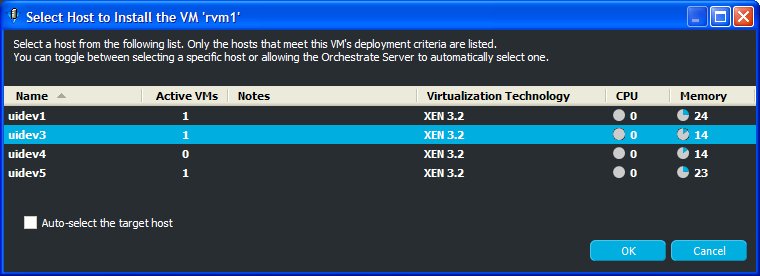5.5 Installing a VM
To install an existing VM definition:
-
(Optional) In the VM Client, click the view, right-click the VM that you want to install, then select .
If you have any changes for the VM, complete those by using the and buttons.
For more information on editing the wizard pages, see Section 5.8, Editing VMs.
-
To install the VM, do one of the following:
-
While you are in the Edit VM wizard, click .
-
In the view, select the defined VM (it shows
 in the column), then click the
in the column), then click the  button.
button.
-
In the view, right-click the defined VM (it shows
 in the column), then select .
in the column), then select .
-
-
One of three possibilities exists for selecting the host on which to build the VM:
-
No valid host exists: If you do not yet have a valid host server to for installing the VM, the following dialog box is displayed:

Review the issues, resolve them, then repeat from Step 2.
-
Only one valid host exists: It is automatically selected, so continue with Step 5.
-
Multiple valid hosts exist: The following dialog box is displayed if there are two or more target host candidates:

Do one of the following:
-
Select the check box.
The option allows the Orchestrate Server to automatically select a host server from those that are available by using a ranking criteria, such as architecture similarity and available CPU and RAM resources. For example, hosts are selected that meet the architecture requirements, the cost of moving information is then considered, and if there is still no clear winner, then the least loaded machine is selected. The ranking criteria can be affected by policies that you might have set in the Development Client.
-
Select the VM host where you want to install the VM.
These options are mutually exclusive, meaning that selecting one disables the other.
-
-
-
Click when you have selected a host server or selected the check box.
-
Do one of the following:
-
If the installation is proceeding from an installation source that requires user input, the VNC is automatically started. Log in with the VNC password to view and interact with the installation as it progresses on the VM’s console, then continue with Step 6.
-
If the installation is using YaST, the VM is automatically installed without user input. You can either manually use VNC (click > ) to view the installation’s progress, or you can continue with Step 6.
-
-
You can view the installation progress in any of the following ways:
-
Observe messages at the bottom of the VM Client interface.
-
Click > or double-click to open the window. In the you can mouse over the entry in the column, or right-click that entry and select , to view the log information for installing the VM.
-
Double-click the VM being installed, click the tab, then double-click the entry related to the installation process that has the
 icon next to it. The Event Log Details dialog box is displayed and is automatically updated as events occur.
icon next to it. The Event Log Details dialog box is displayed and is automatically updated as events occur.
-
View its progress in the tab of the Development Client.
-
-
If you want to cancel the installation before it finished, do one of the following:
-
Select the VM being installed, then click > .
-
Right-click the VM being installed, then select .
The VM’s status is returned to being configured but not installed.
-